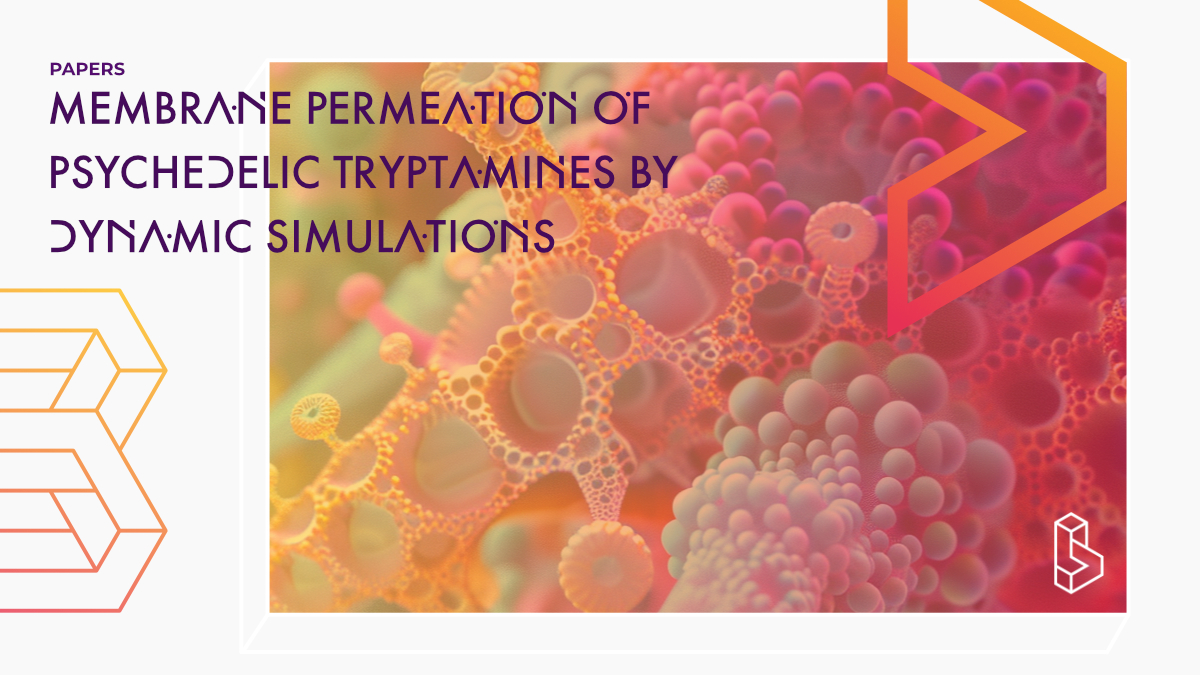This computational study investigates the membrane permeability of 12 selected tryptamines, aiming to elucidate the impact of various structural modifications on their permeation behaviour. Using classical molecular dynamics simulations and umbrella sampling techniques, the study finds that dimethylation of the primary amine group and methoxy substitution at position 5 increase permeability, while positional substitutions on the indole groups and protonation decrease permeability.
Abstract of Membrane Permeation of Psychedelic Tryptamines by Dynamic Simulations
“Renewed scientific interest in psychedelic compounds represents one of the most promising avenues for addressing the current burden of mental health disorders. Classic psychedelics are a group of compounds that exhibit structural similarities to the naturally occurring neurotransmitter serotonin (5-HT). Acting on the 5-HT type 2A receptors (HT2ARs), psychedelics induce enduring neurophysiological changes that parallel their therapeutic psychological and behavioral effects. Recent preclinical evidence suggests that the ability of psychedelics to exert their action is determined by their ability to permeate the neuronal membrane to target a pool of intracellular 5-HT2ARs. In this computational study, we employ classical molecular dynamics simulations and umbrella sampling techniques to investigate the permeation behavior of 12 selected tryptamines and to characterize the interactions that drive the process. We aim at elucidating the impact of N-alkylation, indole ring substitution and positional modifications, and protonation on their membrane permeability. Dimethylation of the primary amine group and the introduction of a methoxy group at position 5 exhibited an increase in permeability. Moreover, there is a significant influence of positional substitutions on the indole groups, and the protonation of the molecules substantially increases the energy barrier at the center of the bilayer, making the compounds highly impermeable. All the information extracted from the trends predicted by the simulations can be applied in future drug design projects to develop psychedelics with enhanced activity.”
Authors: Vito F. Palmisano, Claudio Agnorelli, Andrea Fagiolini, David Erritzoe, David Nutt, Shirin Faraji & Juan J. Nogueira
Summary of Membrane Permeation of Psychedelic Tryptamines by Dynamic Simulations
Introduction
The prevalence of psychiatric diagnoses and the need for treatment is rising, but the efficacy of currently available treatments is insufficient. The recent comeback of psychedelics research represents one of the few promising areas of neuropsychopharmacology.
Psychedelics are a class of psychoactive drugs that act at the 5-HT type 2A receptor, which triggers the release of glutamate and neurotrophic factors, leading to changes in the structural and functional properties of neurons lasting several days following a single drug exposure.
Find this paper
Membrane Permeation of Psychedelic Tryptamines by Dynamic Simulations
https://doi.org/10.1021/acs.biochem.3c00598
Open Access | Google Scholar | Backup | 🕊
Cite this paper (APA)
Palmisano, V. F., Agnorelli, C., Fagiolini, A., Erritzoe, D., Nutt, D., Faraji, S., & Nogueira, J. J. (2024). Membrane Permeation of Psychedelic Tryptamines by Dynamic Simulations. Biochemistry.

